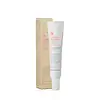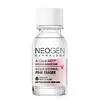What's inside
What's inside
 Key Ingredients
Key Ingredients

 Benefits
Benefits

 Concerns
Concerns

 Ingredients Side-by-side
Ingredients Side-by-side

Centella Asiatica Extract
CleansingWater
Skin ConditioningCalamine
AbsorbentCaprylic/Capric Triglyceride
MaskingCoco-Caprylate/Caprate
EmollientPentylene Glycol
Skin ConditioningSimmondsia Chinensis Seed Oil
EmollientGlycerin
HumectantCetearyl Olivate
Glyceryl Stearate
EmollientCetyl Alcohol
EmollientSorbitan Olivate
EmulsifyingDipotassium Glycyrrhizate
HumectantPropanediol
SolventHouttuynia Cordata Extract
Skin ConditioningEnantia Chlorantha Bark Extract
Skin ConditioningAsiatic Acid
Skin ConditioningMadecassic Acid
Skin ConditioningAsiaticoside
AntioxidantMadecassoside
AntioxidantOleanolic Acid
Skin ConditioningGlyceryl Caprylate
EmollientLauryl Alcohol
EmollientCetearyl Alcohol
EmollientStearyl Alcohol
EmollientMyristyl Alcohol
EmollientXanthan Gum
EmulsifyingAmmonium Acryloyldimethyltaurate/Vp Copolymer
Butylene Glycol
HumectantMelaleuca Alternifolia Leaf Oil
AntioxidantMentha Arvensis Leaf Oil
MaskingHydrogenated Phosphatidylcholine
EmulsifyingSodium Gluconate
Skin Conditioning1,2-Hexanediol
Skin ConditioningSucrose Stearate
EmollientCentella Asiatica Extract, Water, Calamine, Caprylic/Capric Triglyceride, Coco-Caprylate/Caprate, Pentylene Glycol, Simmondsia Chinensis Seed Oil, Glycerin, Cetearyl Olivate, Glyceryl Stearate, Cetyl Alcohol, Sorbitan Olivate, Dipotassium Glycyrrhizate, Propanediol, Houttuynia Cordata Extract, Enantia Chlorantha Bark Extract, Asiatic Acid, Madecassic Acid, Asiaticoside, Madecassoside, Oleanolic Acid, Glyceryl Caprylate, Lauryl Alcohol, Cetearyl Alcohol, Stearyl Alcohol, Myristyl Alcohol, Xanthan Gum, Ammonium Acryloyldimethyltaurate/Vp Copolymer, Butylene Glycol, Melaleuca Alternifolia Leaf Oil, Mentha Arvensis Leaf Oil, Hydrogenated Phosphatidylcholine, Sodium Gluconate, 1,2-Hexanediol, Sucrose Stearate
Water
Skin ConditioningAlcohol Denat.
AntimicrobialCalamine
AbsorbentGlycerin
HumectantMelaleuca Alternifolia Leaf Oil
AntioxidantAsiaticoside
AntioxidantMadecassic Acid
Skin ConditioningAsiatic Acid
Skin ConditioningMadecassoside
AntioxidantCamellia Sinensis Leaf Extract
AntimicrobialOpuntia Coccinellifera Fruit Extract
Skin ConditioningCentella Asiatica Extract
CleansingSapindus Trifoliatus Fruit Extract
Skin ConditioningCamellia Japonica Seed Extract
Skin ConditioningCamellia Japonica Flower Extract
EmollientCitrus Unshiu Peel Extract
MaskingRubus Idaeus Fruit Extract
AstringentCymbopogon Citratus Extract
Skin ConditioningMelissa Officinalis Leaf Extract
Skin ConditioningVaccinium Angustifolium Fruit Extract
Skin ProtectingCitrus Aurantium Dulcis Fruit Extract
MaskingCarica Papaya Fruit Extract
Skin ConditioningCamellia Japonica Leaf Extract
Skin ConditioningGuaiazulene
AntimicrobialPanthenol
Skin ConditioningGlycyrrhiza Glabra Root Extract
BleachingRubus Fruticosus Fruit Extract
AstringentSalicylic Acid
MaskingPEG-60 Hydrogenated Castor Oil
EmulsifyingTrideceth-10
CleansingButylene Glycol
Humectant1,2-Hexanediol
Skin ConditioningEthylhexylglycerin
Skin ConditioningWater, Alcohol Denat., Calamine, Glycerin, Melaleuca Alternifolia Leaf Oil, Asiaticoside, Madecassic Acid, Asiatic Acid, Madecassoside, Camellia Sinensis Leaf Extract, Opuntia Coccinellifera Fruit Extract, Centella Asiatica Extract, Sapindus Trifoliatus Fruit Extract, Camellia Japonica Seed Extract, Camellia Japonica Flower Extract, Citrus Unshiu Peel Extract, Rubus Idaeus Fruit Extract, Cymbopogon Citratus Extract, Melissa Officinalis Leaf Extract, Vaccinium Angustifolium Fruit Extract, Citrus Aurantium Dulcis Fruit Extract, Carica Papaya Fruit Extract, Camellia Japonica Leaf Extract, Guaiazulene, Panthenol, Glycyrrhiza Glabra Root Extract, Rubus Fruticosus Fruit Extract, Salicylic Acid, PEG-60 Hydrogenated Castor Oil, Trideceth-10, Butylene Glycol, 1,2-Hexanediol, Ethylhexylglycerin
Ingredients Explained
These ingredients are found in both products.
Ingredients higher up in an ingredient list are typically present in a larger amount.
1,2-Hexanediol is a synthetic liquid and another multi-functional powerhouse.
It is a:
- Humectant, drawing moisture into the skin
- Emollient, helping to soften skin
- Solvent, dispersing and stabilizing formulas
- Preservative booster, enhancing the antimicrobial activity of other preservatives
Asiatic Acid is a major component of Centella Asiatica Extract. It has wound-healing, anti-inflammatory, and antioxidant properties.
Studies show Asiatic Acid is able to block the pathway for skin inflammation receptors, helping to soothe skin.
As an antioxidant, asiatic acid helps protect our skin against damaging environmental factors.
Learn more about Asiatic AcidAsiaticoside comes from the super popular skin-soothing ingredient, Centella asiatica. It is one of four active compounds found in the extract of Centella Asiatica.
Asiaticoside is an antioxidant and helps with wound healing. It has been shown to increase antioxidant activity during the wound healing process.
Butylene Glycol (or BG) is used within cosmetic products for a few different reasons:
Overall, Butylene Glycol is a safe and well-rounded ingredient that works well with other ingredients.
Though this ingredient works well with most skin types, some people with sensitive skin may experience a reaction such as allergic rashes, closed comedones, or itchiness.
Learn more about Butylene GlycolWe don't have a description for Calamine yet.
Centella Asiatica Extract (Centella) is derived from an herb native to Southeast Asia. It is famous for its anti-inflammatory and soothing properties.
Centella is rich in antioxidants and amino acids, such as Madecassic Acid and Asiaticoside.
Studies show the compounds in centella help with:
The combination of all these properties makes centella effective at soothing, hydrating, and protecting the skin.
Other great components of centella include Vitamin A, vitamin C, several B vitamins, and Asiatic Acid.
Fun fact: Centella has been used as a medicine and in food for many centuries. As a medicine, it is used to treat burns, scratches, and wounds.
Learn more about Centella Asiatica ExtractGlycerin is already naturally found in your skin. It helps moisturize and protect your skin.
A study from 2016 found glycerin to be more effective as a humectant than AHAs and hyaluronic acid.
As a humectant, it helps the skin stay hydrated by pulling moisture to your skin. The low molecular weight of glycerin allows it to pull moisture into the deeper layers of your skin.
Hydrated skin improves your skin barrier; Your skin barrier helps protect against irritants and bacteria.
Glycerin has also been found to have antimicrobial and antiviral properties. Due to these properties, glycerin is often used in wound and burn treatments.
In cosmetics, glycerin is usually derived from plants such as soybean or palm. However, it can also be sourced from animals, such as tallow or animal fat.
This ingredient is organic, colorless, odorless, and non-toxic.
Glycerin is the name for this ingredient in American English. British English uses Glycerol/Glycerine.
Learn more about GlycerinMadecassic Acid is a major component of Centella Asiatica Extract. It has anti-inflammatory and antioxidant properties.
It is a triterpenoid, meaning it naturally acts as an antioxidant. Antioxidants protect your skin against damage from environmental factors such as pollution and UV.
Studies show Madecassic Acid helps soothe the skin due to its ability to block inflammation pathways.
Learn more about Madecassic AcidMadecassoside comes from the super popular skin-soothing ingredient, Centella asiatica. It is one of four active compounds found in the extract of Centella Asiatica.
Madecassoside has antioxidant, anti-inflammatory, and hydrating properties. It contains fatty acids, amino acids, beta-carotene, and phytochemicals.
One study found using Madecassoside with ascorbic acid helped reduce the signs of aging and improved skin hydration.
Learn more about MadecassosideThis tea tree oil comes from the leaves of the Tea Tree plant. Tea tree oil has antioxidant, anti-inflammatory, and antimicrobial properties.
According to the book Journal of Profiles of Drug Substances, tea tree helps in reducing acne-causing bacteria such as Propionibacterium acnes. This is due to the Terpinen components of tea tree oil.
Tea tree may cause sensitivity and irritation for some people. This oil naturally contains fragrance such as linalool and limonene.
However, research shows irritation usually occurs when using pure tea tree oil and not in cosmetic products.
Tea tree oil was found to help relieve the symptoms of psoriasis in one study.
Tea tree oil is toxic when ingested. Another study showed it to caused damage to the nervous system of dogs and cats when applied to their skin or given orally.
Learn more about Melaleuca Alternifolia Leaf OilWater. It's the most common cosmetic ingredient of all. You'll usually see it at the top of ingredient lists, meaning that it makes up the largest part of the product.
So why is it so popular? Water most often acts as a solvent - this means that it helps dissolve other ingredients into the formulation.
You'll also recognize water as that liquid we all need to stay alive. If you see this, drink a glass of water. Stay hydrated!
Learn more about Water